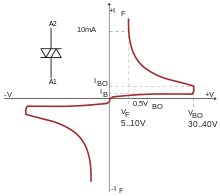DIAC
This article includes alist of references,related reading,orexternal links,but its sources remain unclear because it lacksinline citations.(February 2020) |
| Type | Passive |
|---|---|
| Pin configuration | anode1,anode2 |
| Electronic symbol | |
 | |

TheDIAC(diode for alternating current) is adiodethat conductselectrical currentonly after its breakovervoltage,VBO,has been reached momentarily. Three, four, and five layer structures may be used.[1]Behavior is similar to the voltage breakdown of atriacwithout a gate terminal.
When breakdown occurs, internal positive feedback (impact ionization or two transistor feedback) ensures that the diode enters a region ofnegative dynamic resistance,leading to a sharp increase in current through the diode and a decrease in the voltage drop across it (typically full switch-on takes a few hundred nanoseconds to microseconds). The diode remains in conduction until the current through it drops below a value characteristic for the device, called theholding current,IH.Below this threshold, the diode switches back to its high-resistance, non-conducting state. This behavior isbi-directional,meaning typically the same for both directions of current.
Most DIACs have a three-layer structure with breakover voltage of approximately 30 V and an on voltage of less than 3 V. Their behavior is analogous to the striking and extinction voltages of aneon lamp,but it can be more repeatable and takes place at lower voltages.
DIACs have no gate or triggerelectrode,unlike some otherthyristorsthat they are commonly used to trigger, such asTRIACs.Some TRIACs, likeQuadrac,contain a built-in DIAC in series with the TRIAC's gate terminal for this purpose.
DIACs are also called "symmetrical trigger diodes" due to the symmetry of their characteristic curve. Because DIACs are bidirectional devices, their terminals are not labeled as anode and cathode but as A1 and A2 or main terminal MT1 and MT2.

SIDAC[edit]


Asilicon diode for alternating current(SIDAC) is a less commonly used device, electrically similar to the DIAC, but having, in general, a higher breakover voltage and greater current handling capacity.[citation needed]
The SIDAC is another member of thethyristorfamily. Also referred to as aSYDAC(silicon thyristor for alternating current), bi-directional thyristor breakoverdiode,or more simply a bi-directional thyristor diode, it is technically specified as a bilateral voltage triggered switch. Its operation is similar to that of the DIAC, but a SIDAC is always a five-layer device with low-voltage drop in latched conducting state, more like a voltage triggered TRIAC without a gate. In general, SIDACs have higher breakover voltages and current handling capacities than DIACs, so they can be directly used for switching and not just for triggering of another switching device.
The operation of the SIDAC is functionally similar to that of aspark gap,but is unable to reach its higher temperature ratings. The SIDAC remains nonconducting until the applied voltage meets or exceeds its rated breakover voltage. Once entering this conductive state going through the negative dynamic resistance region, the SIDAC continues to conduct, regardless of voltage, until the applied current falls below its rated holding current. At this point, the SIDAC returns to its initial nonconductive state to begin the cycle once again.
Somewhat uncommon in mostelectronics,the SIDAC is relegated to the status of a special purpose device. However, where part-counts are to be kept low, simplerelaxation oscillatorsare needed, and when the voltages are too low for practical operation of a spark gap, the SIDAC is an indispensable component.
Similar devices, though usually not functionally interchangeable with SIDACs, are thethyristor surge protection device(TSPD) sold under trademarks likeTrisilbySTMicroelectronicsand SIDACtor and its predecessor Surgector byLittelfuse.These are designed to tolerate large surge currents for the suppression of overvoltage transients. In many applications this function is now served bymetal oxide varistors(MOVs), particularly for trapping voltage transients on the power mains.
Applications[edit]
DIACs and SIDACs are often used to deliver a pulse once a capacitor has charged to the breakdown voltage, giving both controlled delay set by the charging resistor and a fixed pulse energy set by the capacitor and breakdown voltage. This is common in simple phase angle controls for AC lamp dimmers and motor speed controls. They may also be used to sense over-voltage fault conditions to provide a 'crowbar' function to operate afuseor a latching alarm that can only be reset by removing the supply.
See also[edit]
References[edit]
General[edit]
External links[edit]
- Strobe circuit containing a SIDAC
- What is a DIACDescription of the DIAC with its operation, applications, use with TRIAC, etc
